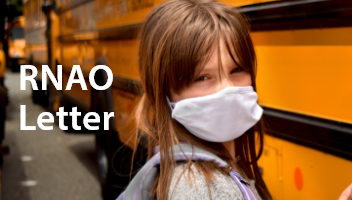RNAO’s advice for reopening schools in Ontario

“Letter to Dr. David Williams, Ontario’s Chief Medical Officer of Health: School re-opening and planning for the 500 public health nurses in Ontario (Aug. 19, 2020)
With approximately two million school-age children and 160,000 teachers in Ontario, it is clear the health and well-being of these children, their parents, teachers and staff must be central to the decision-making process. We must make decisions that avoid major risk to health and life, and continuously consider the impact on the pandemic curve.
Planning for the reopening of schools in September in the safest way possible is central to managing the ongoing challenges that COVID-19 presents to Ontarians’ health, the health of our communities, and our economy. Balancing pandemic health risks related to the reopening of schools with risks related to developmental, mental health and social risks to our children and youth from not opening is the challenge we must get right.
RNAO cannot be fully supportive of the current plan for reopening schools. We are calling for urgent attention to the following by the government to ensure the highest degree of success in this critical step for Ontario children and youth:
- A fundamental factor in the success of school reopening is the continued containment of the virus and absence (or very low levels) of community spread. This may require curtailing other societal activities that are lower priority, such as closing indoor bars and restaurants and reducing numbers for other indoor events.
- The province must rethink its position on not mandating smaller class sizes for elementary schools. This position is unjustified, contradicts the recommendations of experts and public health officials, and may lead to many harmful effects. Class sizes should be reduced and proper funding must flow to the school boards immediately. Time is of the essence.
- Masks must be mandatory for all students in schools. We know children as young as three years of age can be taught to wear a mask and do this consistently over a period of time.
- Assuring physical distancing and appropriate class sizes would allow scheduled breaks from using masks (mandatory for all students) during the school day, targeting their use to situations where there is no physical distancing, such as when students are moving within the classroom, hallways, bathrooms and other congested spaces.
- The opening of schools should be postponed, if necessary, until all the conditions are in place for a safe reopening, including smaller class sizes.
Welcoming 500 school-focused public health nurses (PHN)
RNAO welcomes the provision of $50 million to hire 500 additional, school-focused public health nurses (PHN). These PHNs must be located in public health units to provide rapid- response support to schools and boards in facilitating public health and preventive measures, including screening, testing, tracing and mitigation strategies. These additional registered nurses will also play a key role in ensuring overall mental health in schools, in light of the pandemic, as well as ongoing student health and well-being matters. We believe these should be permanent positions as children and youth would benefit immensely.
RNAO’s position urges the following policy directions to ensure the most effective impact of the PHN role:
- PHNs who are hired in this role should be registered nurses (RN) and ideally RNs with a Bachelor of Science in Nursing (BScN) degree, as per public health standards and the College of Nurses of Ontario (CNO) requirements
- These PHNs must be located in local public health units (PHU) across the province as part of broader public health work under the purview of chief nurse officers, and they must receive on-boarding that, in addition to COVID-19 related information and protocols, includes increased awareness of local community resources for COVID-19 and for mental health, addictions and social services.
- The role of PHNs in schools must include:
- Educating, teaching, training, facilitating, interpreting and communicating COVID- 19 related information to students, parents and teachers. This includes surveillance of and response to COVID-19 symptoms. In-school testing should be considered.
- Contributing to surveillance of children and youth health – especially given the months of lock-down and the reopening under unique circumstances (i.e., physical distancing and wearing of masks).
- The application of the PHN’s existing expertise, critical thinking and problem- solving skills to promote health and well-being in schools, thus ensuring community stability in what are otherwise uncertain times with lots of unpredictability.
- Hiring and on-boarding of PHNs has begun and we are ready to help. The idea is to have all 500 positions filled in August
